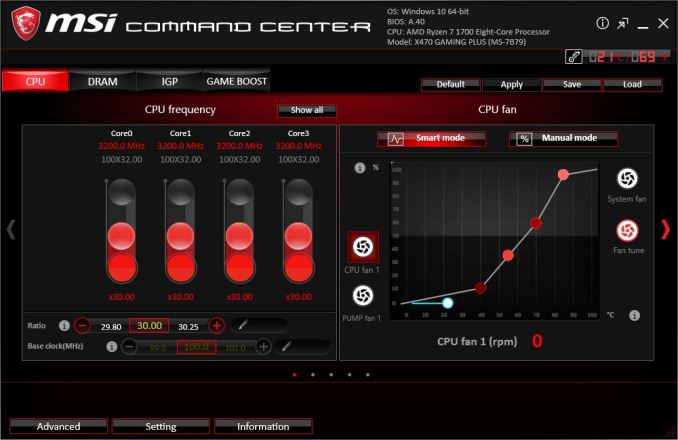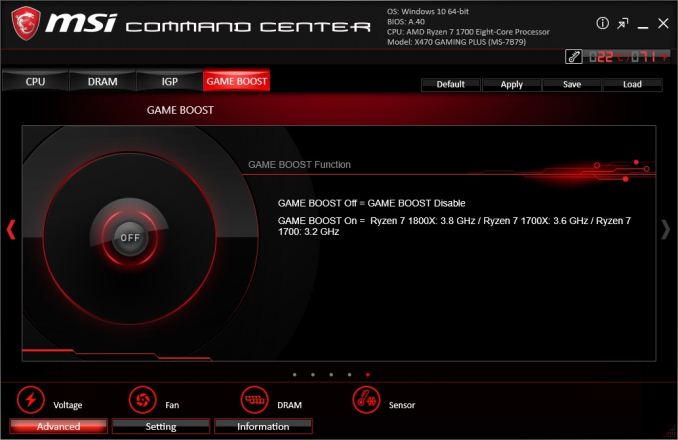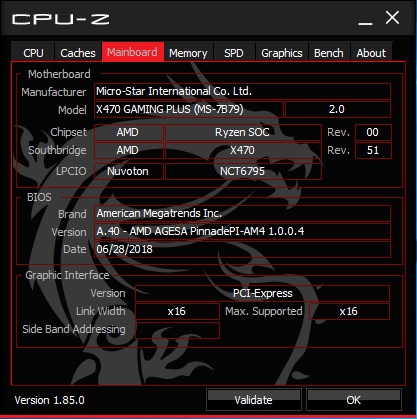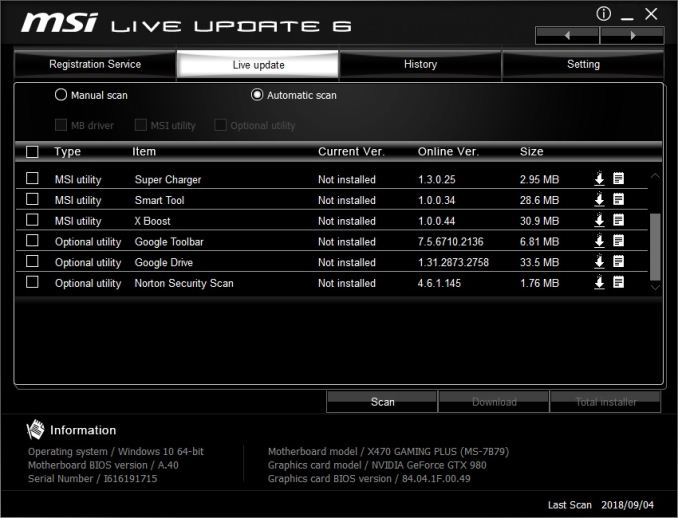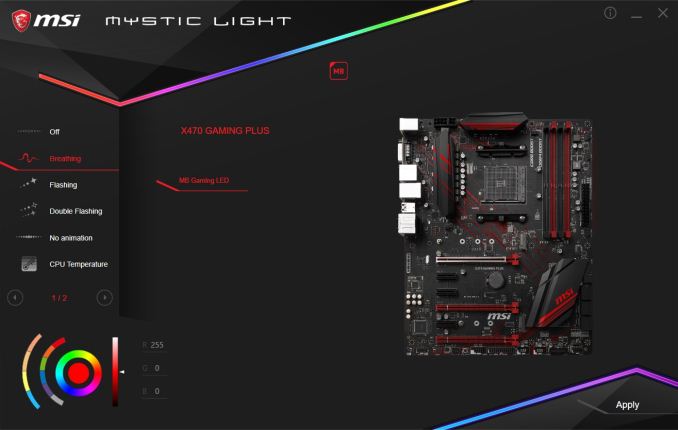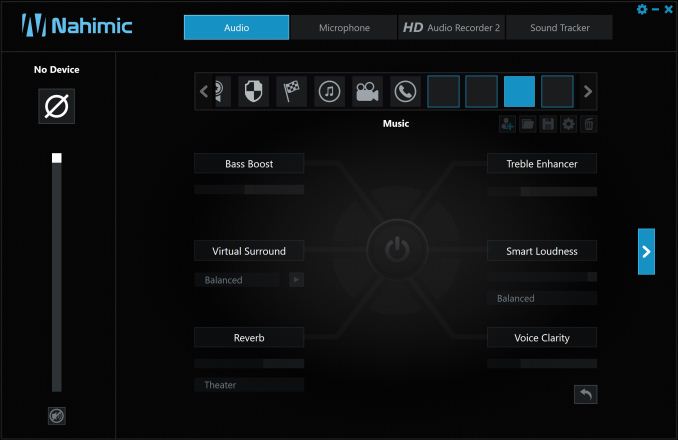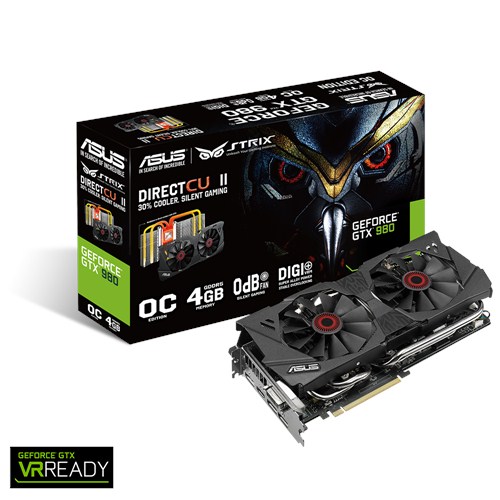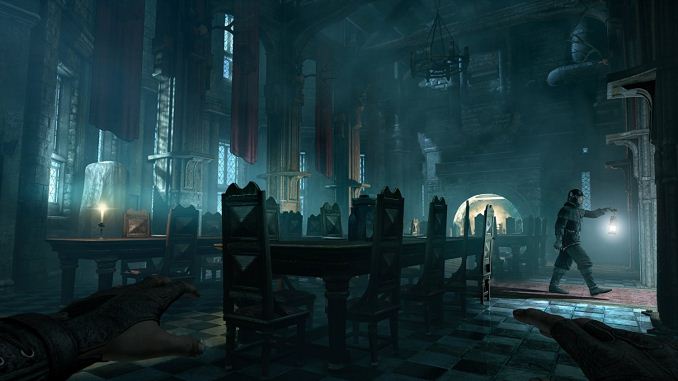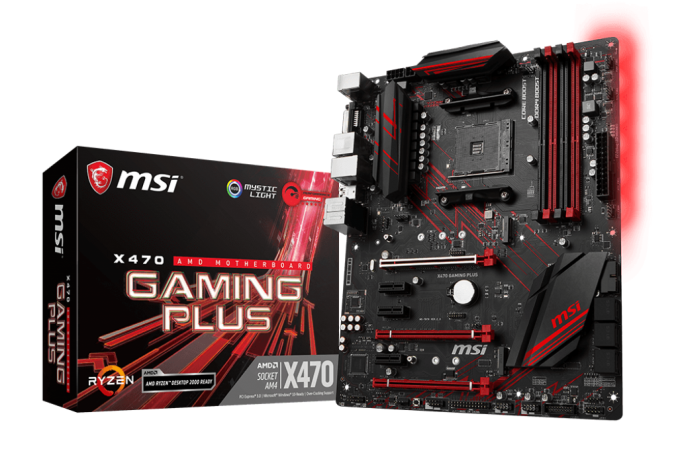
Original Link: https://www.anandtech.com/show/12990/the-msi-x470-gaming-plus-review
The $120 MSI X470 Gaming Plus Review: Only 4-Phase VRM, Not 11-Phase as Advertised
by Gavin Bonshor on October 4, 2018 10:00 AM EST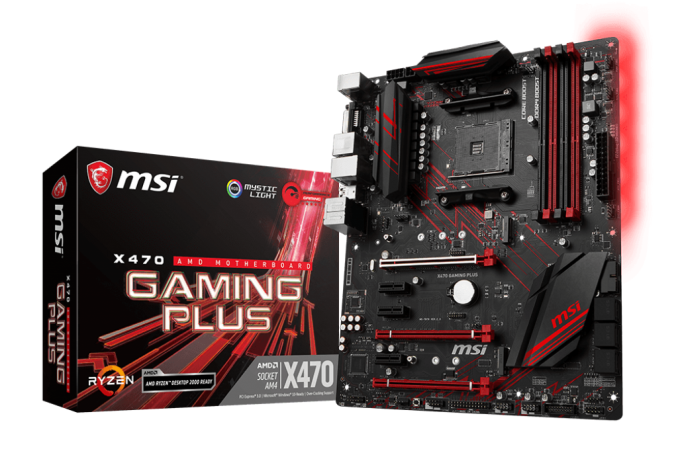
Low budget doesn’t necessarily mean low quality, and although there are always exceptions to this rule, MSI looks to break the stigma behind this with their lowest cost X470 chipset motherboard, the X470 Gaming Plus. This model is specifically aimed at gamers looking to be more gingerly with their cash which allows users to potentially upgrade their other components without sacrificing too much on quality. With a selection of components including a Realtek pairing consisting of an ALC892 HD audio codec and RTL8111H Gigabit LAN controller, MSI’s attempt to dominate the low to mid-range X470 market with this $120 offering hinges on its implementation and performance.
The MSI X470 Gaming Plus Overview
We’ve seen a steep increase in ‘gaming’ branded motherboards over the last half a decade and the one on our test bench today is at the forefront of the 'gaming' mantra. The MSI X470 Gaming Plus is a mid-range gaming themed motherboard which as it currently stands (at the time of writing) is the cheapest full-sized ATX X470 entry-level option at a cost of $120. For the $120 MSI have included a selection of mid-level controllers such as a Realtek ALC892 HD audio codec which offers five 3.5mm gold plated audio jacks and a S/PDIF optical out, as well as a Realtek RTL8111H Gigabit controller powering the single LAN port on the rear panel of the board. Further connections include a pairing of video outputs consisting of a DVI-D and an HDMI 1.4 port. The X470 Gaming Plus is compatible with the Ryzen 2000 series APUs, the Ryzen 5 2400G ($169) and Ryzen 3 2200G ($99) on top of the Ryzen first and second-generation desktop processors. A total of four USB 3.1 Gen1 Type-A ports make up the bulk of the rear panel USB real estate an additional two USB 2.0 ports. MSI has opted to omit any USB Type-C ports and has instead chosen to include two USB 3.1 Gen2 Type-A ports. Users of older keyboard and mice can make use of the included PS/2 combo port.
MSI has gone with what they advertise as an 11-phase power design, but upon closer inspection, it’s actually pumped up as it is running in 4+2 configuration, with a Richtek RT8894A PWM controller handling things from a power perspective. We go into this more in the review. MSI do include an 8-pin 12V ATX power input for providing power to the CPU as well as an additional 4-pin for users looking to overclock their processors. RGB customization is present on this model with a total of eight underside RGB LEDs located on the right-hand side on the underside of the board. Users wanting to add more RGB or light to their system can do so with the inclusion of two 5050RGB LED 12 V headers. Cooling capability is provided by a total of six 4-pin headers split between one for a CPU fan, one for a water cooling/AIO pump and four dedicated to case fans.
Memory support is good for a mid-range model with DDR4-3466 RAM support out of the box and the X470 Gaming Plus has the capacity for up to 64 GB across the four available memory slots. The storage options include six SATA ports and two M.2 slots; one has PCIe 3.0 x4/SATA support whereas the other supports PCIe 2.0 x4/SATA drives. The X470 Gaming Plus has a total of three full-length PCIe slots with two operating at PCIe 3.0 x16 and the bottom slot operating at PCIe 2.0 x4. In addition to these is three PCIe 2.0 x1 slots for use with expansion cards such as sound cards and RAID cards.
Overall performance from the MSI X470 Gaming Plus is relatively average from our test suite, but on the whole, the performance from our motherboard testing suite was positive and consistent with what was expected from a $120 entry level X470 model. The most positive result from our testing came in the way of power consumption, more specifically power consumption under load with the X470 Gaming Plus achieving one of the lowest results given, which is around 6 watts lower under load at stock than MSI’s own B350 Tomahawk which we tested back in March of this year. The biggest disappointment was in our non-UEFI POST time test in which this board gave us the worst performance seen so far, with a total POSTing time of around 26 seconds at default and when stripped; it was actually quite reminiscent of the performance MSI’s own MEG X399 Creation TR4 motherboard displayed.
On the overclocking front the X470 Gaming Plus performs respectably, and managed to achieve the 4.0 GHz limit the silicon in our Ryzen 7 1700 processor seems to max out at. The VDroop applied by this board was modest with a maximum of 0.02 V extra applied over the value set within the BIOS at 4.0 GHz. This board does have an additional 4-pin available on top of the 8-pin ATX 12 V CPU power input and MSI advertises an 11-phase power delivery under the heatsinks. Underneath the heatsinks, there is an 11-phase VRM present, but the real configuration is revealed in our visual inspection of the board.
The MSI X470 Gaming Plus is currently priced at $120 on Newegg and represents a gaming-themed entry-level option onto the X470 chipset and AM4 socket. This pricing puts this model in competition with models such as the GIGABYTE X470 Aorus Ultra Gaming at $129, while the lowest cost X470 ATX options from ASUS and ASRock start from upwards of $140. This is the segment of the market where MSI do very strongly and remain highly competitive, MSI even went as far as informing me that the X470 Gaming Plus is their most popular X470 model from a sales perspective.
Visual Inspection
The MSI X470 Gaming Plus is an ATX gaming centered motherboard designed to offer users a lower cost alternative onto the X470 chipset. The bulk of the aesthetics is dominated by the jet-black PCB which has red lightning like streaks emanating from the top left-hand corner towards the bottom right-hand side. The power delivery heatsinks keep to the same pattern and fit in well with the design with the heatsink covering the X470 chipset also blending in with the printed design onto the PCB. The X470 Gaming Plus does have built-in lighting integrated into the board with eight RGB LEDs arranged in a straight line to create a light bar effect underneath the top right-hand corner of the board. Users looking to extend the RGB capabilities can do so thanks to the inclusion of two 5050 12 V RGB LED strip connectors; the lighting effects and colors can be synced using MSI’s Mystic Light software.
Storage wise the board packs a total of six SATA ports which features support for RAID 0, 1 and 10 arrays. The board also has a total of two M.2 slots with the top slot having a PCIe 3.0 x4 interface as well as supporting SATA based drives up to a size of M.2 22110. The second slot offers support for drives up to a size of M.2 2280 and has a PCIe 2.0 x4 interface and also supports SATA drives. This second slot does share bandwidth with other slots dependent on whether a SATA or PCIe based M.2 is being used; if a PCIe drive is being used, the full-length PCIe 2.0 x4 located at the bottom of the board will be disabled and if a SATA drive is installed, the first SATA port (SATA1) will become non-functional.
From a cooling perspective, the X470 Gaming Plus has a total of six 4-pin fan controllers which gives it one less than the near priced GIGABYTE X470 Aorus Ultra Gaming ($130). The headers are divided into three areas with one header dedicated to a CPU fan, four to regular system fans and one assigned for users planning on using a water-cooling pump or AIO; the pump header supports pumps up to a maximum of 2A. Located at the base of the board is a clear CMOS button which allows users to simply clear and reset the BIOS settings back to factory defaults; one of the first steps recommended in hardware issue troubleshooting.
Touching more on the PCI capabilities of the X470 Gaming Plus, the board has two full-length PCIe 3.0 x16 slots with the slot located at the top of the slots getting a coating of MSI’s Steel Slot protection. At the bottom is a full-length PCIe 2.0 x4 slot and located between the full-length slots are a total of three PCIe 2.0 x1 slots. This particular X470 model does have support for 2-way and 3-way CrossFire multi-graphics card setups, but users looking to utilize NVIDIA SLI setups will be disappointed to find there is zero support available. MSI do offer an alternative X470 model that supports SLI configurations, but the X470 Gaming Pro Carbon ($180) does cost $60 more than this particular model that is being reviewed today.
The X470 Gaming Plus offers support for dual channel memory with RAM up to DDR4-3466, with a combined total of up to 64 GB supported over four available RAM slots. This model also allows users to use ECC memory with official support from MSI confirmed. Any installed ECC DDR4 memory will operate in unbuffered mode.
The power delivery on the X470 Gaming Plus is somewhat modest when all things are considered, even though MSI are themselves advertising this model to have an 11-phase power design, when in fact it’s actually an 8-phase arrangement running in a 4+2 configuration. Firstly, the PWM controller of choice is a single Richtek RT8894A dual channel controller which is designed to run at a maximum configuration of 4+2 which means a true 11-phase design isn’t possible. The core elements of the power delivery consist of fourteen 4C929N high side MOSFETs with an additional fourteen 4C024N low side MOSFETs; both models of MOSFETs are manufactured by ON Semiconductor.
| AM4 Motherboard Power Delivery Comparison | ||||||
| AnandTech | Controller | Doubler | True CPU Phases | H Side |
L Side |
Chokes |
| ASRock | ||||||
| B450 Gaming ITX/ac | ISL95712 (3+2) | - | 3 | 10 | 10 | 8 |
| B450 Gaming K4 | ISL95712 (3+3) | - | 3 | 12 | 9 | 9 |
| X470 Taichi Ultimate | IR35201 (6+2) | 8 | 6x2 = 12 | 16 | 16 | 16 |
| Biostar | ||||||
| Biostar X370GTN | ISL95712 (4+3) | - | 4 | 7 | 7 | 7 |
| Biostar X470GTN | ISL95712 (4+3) | - | 4 | 7 | 7 | 7 |
| GIGABYTE | ||||||
| X470 Gaming 7 Wi-Fi | IR35201 (5+2) | 5 | 5x2 = 10 | 12 | 12 | 12 |
| MSI | ||||||
| X370 Gaming Titanium | IR35201 (6+2) | 6 | 5x2 = 10 | 10 | 16 | 10 |
| X470 Gaming Plus | RT8894A (4+2) | - | 4 | 14 | 14 | 11 |
This particular power delivery is split into three separate sections, the CPU, the rest of the SoC, and the memory. The VCore section which is the most important aspect as it’s designed to provide power to the processor consists of 4-phase set up with each individual phase getting two ON 4C024N low side and two ON 4C929 high side MOSFETs per channel. Each quadruplet of MOSFETs runs in parallel and gets its own dedicated choke. Due to the use of a Richtek RT8894A 4+2 PWM controller, this means MSI cannot use doublers to multiply the phase count as the controller simply doesn’t support it, so to make them run in tandem with each other, MSI has shorted each pair of phases on the which can be seen on the rear of the board making the X470 Gaming Plus seem like it’s an 8-phase on the surface, but deep down it’s actually a 4-phase; very misleading to the consumer who might not have the technical prowess to decipher that one choke doesn’t equal one individual phase.
The power delivery for the rest of the chip features the same array of high and low side MOSFETs as the CPU element but is made up of two high-side pairs and two low-side pairs, giving the rest of the SoC a total of two true phases. The memory gets its own dedicated phase with one ON 4C024N low side and one ON 4C929N high side MOSFET. Each DRAM channel has its own choke. The memory section can be found just on the right-hand side of the four RAM slots and consists of two high and low side MOSFETs which are exactly the same as used on both the VCore and SoC area, with a single choke finishing off a needlessly complex, but also relatively basic 7-phase (4+2+1) power delivery; not an 11-phase like MSI suggests.
While most high-end X470 motherboards come equipped with an ALC1220 HD audio codec from Realtek, MSI has armed the X470 Gaming Plus with a slightly lesser quality Realtek ALC892 HD audio codec to bring down the price point. The included ALC892 HD audio codec offers a rated 95 dB signal to noise ratio (SNR) while the more premium ALC1220 advertises a 120 dB SNR. While not a big deal on an entry-level offering, MSI has shaved off some production cost doing this and it does kind of explain why MSI has been able to justify a $10 cheaper price than the competitive GIGABYTE X470 Aorus Ultra Gaming ($129). The audio PCB on the X470 Gaming Plus itself features separation and the ALC892 HD audio codec is complemented by eight gold audio capacitors manufactured by Nippon Chemicon.
On the rear panel, most of the space is taken up by USB connections which are split into three different interfaces. The USB connectors residing on the rear panel consist of four USB 3.1 Gen1 Type-A ports, two USB 2.0 Type-A ports and two 10 Gbps USB 3.1 Gen2 Type-A ports; MSI has opted to go for the more commonly used Type-A with its USB 3.1 Gen2 ports rather than including any Type-C functionality whatsoever. Users looking to expand further upon the rear panel USB provided can do so thanks to two USB 3.1 Gen1 headers (four ports) and two USB 2.0 headers (four ports). Other ports include a PS/2 keyboard and mouse combo port, as well as a pair of video outputs to utilize AMD’s Ryzen 2000 series APUs which include a DVI-D and an HDMI 2.0 port. The Realtek ALC892 HD audio codec provides a total of five 3.5 mm gold plated audio jacks as well as a single S/PDIF optical output. Finishing off the rear panel of the X470 Gaming Plus is a single LAN port which is powered by a more budget-friendly Realtek RTL8111H which is a regular companion on motherboards which feature the ALC887 and ALC892 codecs.
What's in The Box
MSI has included a modest offering of accessories with its X470 Gaming Plus model with all of the necessary and key elements for a user to get their system up and running out of the box. The key inclusions are a black and red gaming themed IO shield, two SATA cables, a user guide dedicated to this model and a driver installation CD. The case stand-off notification sheet is a welcomed addition as users not too experienced in installing and building systems will find this useful in avoiding potential damage and shorts, but for users who usually skip over the documentation will find these zones clearly marked on the rear of the boards PCB.
- User manual and quick installation guide
- Driver installation CD
- Case stand-off notification guide
- 2 x M.2 installation screws
- 2 x SATA cables (1 right-angled, 1 straight-angled)
- Cable label sticker sheet
- Rear IO shield
- MSI Gaming shield sticker
- MSI thank you card
BIOS
MSI for the entirety of its AM4 motherboard line-up uses its Click BIOS 5 interface, which has a very easy to use ‘Easy’ mode upon entry after pressing the Del or F2 key. The GUI follows a familiar red and black ‘gaming’ theme throughout the entirety of the BIOS with white text on a black background. When each option is highlighted, the selection is signified by a red background across the option.
The entry screen displays core information about installed components such as the CPU and memory in the top third of the screen, while the rest of the screen gives different options for information windows which include flashing the BIOS, among other things. The two main fundamentals on the EZ mode are the GAME BOOST one-click CPU overclocking button and A-XMP memory tools for easy and automatic overclocking, which incidentally remain on the top panel throughout the entirety of the BIOS.
The Game Boost button applies different settings based on whatever processor is installed. For reference and first-generation Ryzen users, the Game Boost applies a 3.8 GHz overclock to a Ryzen 7 1800X, 3.6 GHz to a Ryzen 7 1800 and a very modest 3.2 GHz to a Ryzen 7 1700 processor. It seems MSI has gone with a less aggressive approach of hammering voltages as with Game Boost applied our Ryzen 7 1700 processor at maximum load would pump a very conservative 1.2 V through our test bench chip. This is a remarkable improvement as the B350 Tomahawk Game Boost would apply 1.4 V, but with a 200 MHz higher clock speed than this X470 Gaming Plus; a trade-off I would be willing to live with as 1.4 V is relatively high for 24/7 use at such a low clock speed.
Moving onto the ‘advanced’ section which can be accessed by pressing the F7 key has a nice Gaming Plus graphic in the center of the screen. The advanced section opens up a wealth of different and easily accessible sections of the BIOS which includes the OC section for overclocking the CPU and memory, an M-Flash section or updating the boards firmware to the latest version, a visually basic but effective hardware monitor for setting and creating custom fan profiles and board explorer which allows users to navigate around a graphic model of the X470 Gaming Plus, and it’s installed components.
In the OC section all the options in relation to overclocking the installed processor and memory are available for tweaking. All the relevant settings for adjusting the processor's ratio which users can do in 100 MHz increments. Due to this model not featuring an external clock generator, the base clock frequency is locked down to 100 MHz. Memory wise this board officially supports DDR4-3466 but opening up the DRAM frequency option reveals that a maximum of DDR4-4200 can be selected; it is highly unlikely that any user will manage to achieve this on ambient cooling methods, or at all due to the integrated memory controller onboard the SoC.
The hardware monitor interface is clean, informative and allows users to control installed fans through a multi-point temperature and power curve. Each fan can be controlled individually and compatible fans can be switched between DC and PWM modes.
Having an intuitive board explorer is beneficial for a couple of reasons. First of all, it allows users to get a bird’s eye view of the board, with installed components in the different slots and headers highlighting up in red. Clicking on each of the highlighted areas brings up basic information about what’s currently installed such as the memory, devices plugged into the rear panel and even the processor installed into the AM4 socket.
One of the favorable elements to the MSI Click BIOS 5 interface is the clean aesthetics and how responsive this UEFI BIOS is on the whole. It’s a solid play for MSI on many levels and the main axiom they have gone for seems to be ‘if it’s not broken, don’t fix it’. Another major improvement from a novice users point of view is the Game Boost one-click overclocking button applies much less voltage than we have seen from the first generation of AM4 motherboards. While the frequency settings on our Ryzen 1700 processor are applied more cautiously than other models, so is the voltage and is a better trade-off to make in terms of heat and power generated by 1.4 V of VCore through an eight-core processor such as this one. That being said MSI has a great UEFI BIOS and for a $120 model, all the options required for the average user is covered, including some of the more hardcore enthusiasts with many options to tweak memory timings and sub-timings being some of the most notable to mention.
Software
Most of the following analysis on this page is taken from our MSI MEG X399 Creation motherboard review as the majority of the software package provided with the X470 Gaming Plus remains much the same.
One thing MSI like to do to is bolster their gaming branded boards with an overabundance of software so that users can make the most of their purchase. Just like other vendors do, MSI keeps to a set core of software and applications such as MSI’s Command Center which gives users the ability to overclock their systems without needing to use the BIOS. Other notable utilities include an MSI gaming skinned CPU-Z monitoring application, the MSI Mystic Light RGB which allows users to customize the color and effects of the RGB LEDs, as well as the headers and the Nahimic 2+ audio utility which gives users scope to customize their listening experiences based on what kind of audio is being played back etc music, gaming or film/TV.
The MSI Command Center utility provides a variety of informative monitoring abilities as well as allowing users to overclock their system within Windows. The CPU frequency option enables users to either click and drag the interactive slider up to the desired core clock speed, or it can be done incrementally in steps of 25 MHz via the plus and minus buttons. The Command Center app does inhibit the ability to directly change memory voltages, and instead users can select through the different Game Boost profiles and enable them this way. The MSI Command Center app also includes a hardware monitor similar to what's inside the BIOS and has a slightly less intimidating fan profile selection tool.
The Game Boost section within MSI’s Command center software gives users the ability to enable the Game Boost function which mirrors the one-click button within the BIOS. It’s informative in terms of what the button applies settings wise, but it would have been a nice touch to include that the voltages as each of the three listed CPUs gets the exact same overclock applied regardless of different silicon. While the X470 was launched simultaneously with the second generation of Ryzen processors such as the Ryzen 7 2700X, the software doesn’t list any of the settings it may apply to the newer selection of chips which I was actually expecting it to do.
A custom MSI Gaming themed CPU-Z skin is available to download, or via the installation CD (though it's always recommended once online to update to the latest version). CPU-Z is a monitoring utility created by CPUID and allows users the ability to monitor CPU core voltage, CPU frequency as well as the set multiplier, base clock (bus) speed, and other CPU and memory relevant settings such as CAS latency timings and memory frequency.
MSI's Live Update 6 software can be quite useful for updating motherboard drivers and software to the latest versions. Users can download with the intention to install manually or use the total installer button which downloads the software and installs it automatically saving time. There are options to scan for software automatically or manually if there's a certain app or utility that's required, although a full list of supported utilities can be installed directly from the installation CD, or via the product page from the MSI website.
While the current version of the MSI Click BIOS 5 UEFI firmware doesn’t have any functionality or scope to customize the onboard RGB LEDs, users can do so by using the MSI Mystic Light software. The Mystic Light software allows users to not only control and customize the color of the RGB LEDs integrated into the board, but it also offers customization of the two included 5050 RGB 12 V headers too. Users can select between seven different lighting effects such as breathing, flashing or even select a light show based on music or current CPU temperature. Users wishing to avoid the RGB craze can turn the LEDs off, or set and sync the integrated LEDs and RGB headers to a solid color if they so wish.
The MSI and A-Volute partnership stretches all the way back to 2014 and the result came a year later through the Nahimic brand. The Nahimic 2+ audio software allows users to tweak and change effects based on the audio that’s being played and offers a futuristic interface to boot. Users can select between different preset profiles such as music, gaming and film, with the option to change certain auditory characteristics such as bass, treble and virtual surround sound. The microphone option offers basic voice shaping technology which can be fun during VOIP conversations, but it’s not something I have ever felt the need to utilize. The most important feature within gaming is the Sound Tracker option with users gaining the ability to toggle and test sound from their headset and speakers coming from different locations; this is basically virtual surround sound specifically for gaming.
The software included from MSI follows the same design and gaming themed properties as the X470 Gaming Plus itself and does offer some useful customizations for the integrated RGB LED lighting and a more immersive audio experience through the Realtek ALC892 HD audio codec. The Command Center utility offers much of what the BIOS does in terms of overclocking setting aside from more in-depth options such as RAM latency sub-timings, but much of what a novice user might be familiar with is included.
Board Features
For an entry-level X470 offering, MSI has equipped the X470 Gaming Plus with plenty of familiar controllers such as a pairing of more wallet-friendly Realtek controllers with the ALC892 HD audio codec and RTL8118H Gigabit networking chip. MSI has also equipped the board with an additional 4-pin 12 V ATX power input on top of the 8-pin 12 V ATX connector most ATX boards of this pedigree come with. This is designed to allow the power delivery to pull extra power when needed from a power supply and although it looks good on paper, it's not really necessary on a board such as this. Overclocking Ryzen first and second generation processors is easy enough on this board thanks to the MSI Click BIOS 5 UEFI firmware, but it's highly unlikely users will manage to need 12-pins of 12 V ATX power. The X470 Gaming Plus has support for two and three-way AMD CrossFire graphics configurations, but one of the main benefits over B450 is the inclusion of SLI support which has been omitted completely on this model.
| MSI X470 Gaming Plus ATX Motherboard | |||
| Warranty Period | 3 Years | ||
| Product Page | Link | ||
| Price | $120 | ||
| Size | ATX | ||
| CPU Interface | AM4 | ||
| Chipset | AMD X470 | ||
| Memory Slots (DDR4) | Four DDR4 Supporting 64 GB Dual Channel Up to DDR4-3466+ |
||
| Video Outputs | 1 x HDMI 2.0 1 x DVI-D |
||
| Network Connectivity | Realtek RTL8118H Gigabit | ||
| Onboard Audio | Realtek ALC892 | ||
| PCIe Slots for Graphics (from CPU) | 1 x PCIe 3.0 x16 1 x PCIe 3.0 x8 |
||
| PCIe Slots for Other (from PCH) | 1 x PCIe 2.0 x4 3 x PCIe 2.0 x1 |
||
| Onboard SATA | Six, RAID 0/1/10 | ||
| Onboard M.2 | 1 x PCIe 3.0 x4/SATA 1 x PCIe 2.0 x4/SATA |
||
| USB 3.1 (10 Gbps) | 2 x Type-A Rear Panel | ||
| USB 3.0 (5 Gbps) | 4 x Type-A Rear Panel 2 x Header (four ports) |
||
| USB 2.0 | 2 x Type-A Rear Panel 2 x Header (four ports) |
||
| Power Connectors | 1 x 24-pin ATX 1 x 8pin CPU 1 x 4pin CPU |
||
| Fan Headers | 1 x CPU (4-pin) 1 x Pump/AIO (4-pin) 4 x System (4-pin) |
||
| IO Panel | 2 x USB 3.1 Gen2 Type-A 4 x USB 3.1 Gen1 Type-A 2 x USB 2.0 Type-A 1 x Network RJ45 (Realtek) 1 x HDMI 2.0 1 x DVI-D 1 x Combo PS/2 5 x 3.5mm Audio Jacks (Realtek) 1 x S/PDIF Output (Realtek) |
||
The intent from MSI is clear in that this board is completely gaming-centric in the design and implementation of the componentry. MSI has used some budget to cater for the needs of users looking to utilize one of the Ryzen 2000 series APUs with an HDMI 2.0 and DVI-D output present on the rear panel. Both of the included M.2 ports on X470 Gaming Plus support both PCIe and SATA storage drives, but only one of them (top slot) has PCIe 3.0 x4 capability for using those super fast NVMe based M.2 drives. Being a budget option MSI hasn't included any heatsinks or thermal coverage for the M.2 slots. The X470 Gaming Plus has a total of eight USB ports on the rear panel with the option to expand by an additional eight with the use of onboard headers. MSI decided against including any form of USB Type-C connectivity and networking capability comes through a single LAN port powered by the Realtek RTL8118H Gigabit controller.
Test Bed
As per our testing policy, we take a high-end CPU suitable for the motherboard that was released during the socket’s initial launch, and equip the system with a suitable amount of memory running at the processor maximum supported frequency. This is also typically run at JEDEC subtimings where possible. It is noted that some users are not keen on this policy, stating that sometimes the maximum supported frequency is quite low, or faster memory is available at a similar price, or that the JEDEC speeds can be prohibitive for performance. While these comments make sense, ultimately very few users apply memory profiles (either XMP or other) as they require interaction with the BIOS, and most users will fall back on JEDEC supported speeds - this includes home users as well as industry who might want to shave off a cent or two from the cost or stay within the margins set by the manufacturer. Where possible, we will extend out testing to include faster memory modules either at the same time as the review or a later date.
| Test Setup | |||
| Processor | AMD Ryzen 7 1700, 65W, $300, 8 Cores, 16 Threads, 3GHz (3.7GHz Turbo) |
||
| Motherboard | MSI X470 Gaming Plus (Bios vA4) | ||
| Cooling | Thermaltake Floe Riing RGB 360 | ||
| Power Supply | Thermaltake Toughpower Grand 1200W Gold PSU | ||
| Memory | 2x16GB Corsair Vengeance LPX DDR4-2400 | ||
| Video Card | ASUS GTX 980 STRIX (1178/1279 Boost) | ||
| Hard Drive | Crucial MX300 1TB | ||
| Case | Open Test Bed | ||
| Operating System | Windows 10 Pro | ||
Readers of our motherboard review section will have noted the trend in modern motherboards to implement a form of MultiCore Enhancement / Acceleration / Turbo (read our report here) on their motherboards. This does several things, including better benchmark results at stock settings (not entirely needed if overclocking is an end-user goal) at the expense of heat and temperature. It also gives, in essence, an automatic overclock which may be against what the user wants. Our testing methodology is ‘out-of-the-box’, with the latest public BIOS installed and XMP enabled, and thus subject to the whims of this feature. It is ultimately up to the motherboard manufacturer to take this risk – and manufacturers taking risks in the setup is something they do on every product (think C-state settings, USB priority, DPC Latency / monitoring priority, overriding memory sub-timings at JEDEC). Processor speed change is part of that risk, and ultimately if no overclocking is planned, some motherboards will affect how fast that shiny new processor goes and can be an important factor in the system build.
Many thanks to...
Thank you to ASUS for providing us with GTX 980 Strix GPUs. At the time of release, the STRIX brand from ASUS was aimed at silent running, or to use the marketing term: '0dB Silent Gaming'. This enables the card to disable the fans when the GPU is dealing with low loads well within temperature specifications. These cards equip the GTX 980 silicon with ASUS' Direct CU II cooler and 10-phase digital VRMs, aimed at high-efficiency conversion. Along with the card, ASUS bundles GPU Tweak software for overclocking and streaming assistance.
The GTX 980 uses NVIDIA's GM204 silicon die, built upon their Maxwell architecture. This die is 5.2 billion transistors for a die size of 298 mm2, built on TMSC's 28nm process. A GTX 980 uses the full GM204 core, with 2048 CUDA Cores and 64 ROPs with a 256-bit memory bus to GDDR5. The official power rating for the GTX 980 is 165W.
The ASUS GTX 980 Strix 4GB (or the full name of STRIX-GTX980-DC2OC-4GD5) runs a reasonable overclock over a reference GTX 980 card, with frequencies in the range of 1178-1279 MHz. The memory runs at stock, in this case 7010 MHz. Video outputs include three DisplayPort connectors, one HDMI 2.0 connector and a DVI-I.
Further Reading: AnandTech's NVIDIA GTX 980 Review
Thank you to Crucial for providing us with MX200/MX300 SSDs. Crucial stepped up to the plate as our benchmark list grows larger with newer benchmarks and titles, and the 1TB units are strong performers. The MX200s are based on Marvell's 88SS9189 controller and using Micron's 16nm 128Gbit MLC flash, these are 7mm high, 2.5-inch drives rated for 100K random read IOPs and 555/500 MB/s sequential read and write speeds. The 1TB models we are using here support TCG Opal 2.0 and IEEE-1667 (eDrive) encryption and have a 320TB rated endurance with a three-year warranty.
Further Reading: AnandTech's Crucial MX200 (250 GB, 500 GB & 1TB) Review
Thank you to Corsair for providing us with Vengeance LPX DDR4 Memory
Corsair kindly sent a set of their Vengeance LPX low profile, high-performance memory. The heatsink is made of pure aluminum to help remove heat from the sticks and has an eight-layer PCB. The heatsink is a low profile design to help fit in spaces where there may not be room for a tall heat spreader; think a SFF case or using a large heatsink.
System Performance
Not all motherboards are created equal. On the face of it, they should all perform the same and differ only in the functionality they provide - however, this is not the case. The obvious pointers are power consumption, but also the ability for the manufacturer to optimize USB speed, audio quality (based on audio codec), POST time and latency. This can come down to manufacturing process and prowess, so these are tested.
Power Consumption
Power consumption was tested on the system while in a single ASUS GTX 980 GPU configuration with a wall meter connected to the Thermaltake 1200W power supply. This power supply has ~75% efficiency > 50W, and 90%+ efficiency at 250W, suitable for both idle and multi-GPU loading. This method of power reading allows us to compare the power management of the UEFI and the board to supply components with power under load, and includes typical PSU losses due to efficiency. These are the real world values that consumers may expect from a typical system (minus the monitor) using this motherboard.
While this method for power measurement may not be ideal, and you feel these numbers are not representative due to the high wattage power supply being used (we use the same PSU to remain consistent over a series of reviews, and the fact that some boards on our test bed get tested with three or four high powered GPUs), the important point to take away is the relationship between the numbers. These boards are all under the same conditions, and thus the differences between them should be easy to spot.
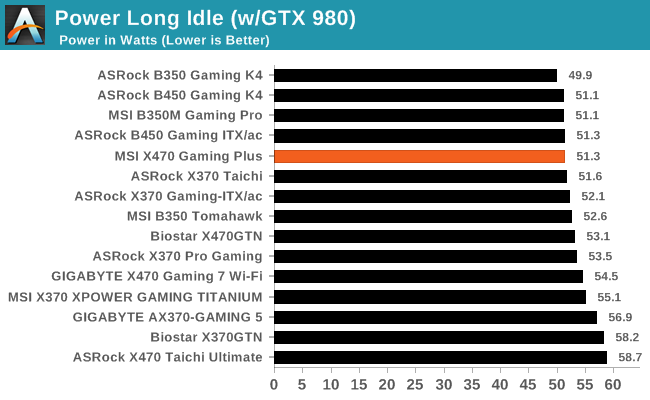
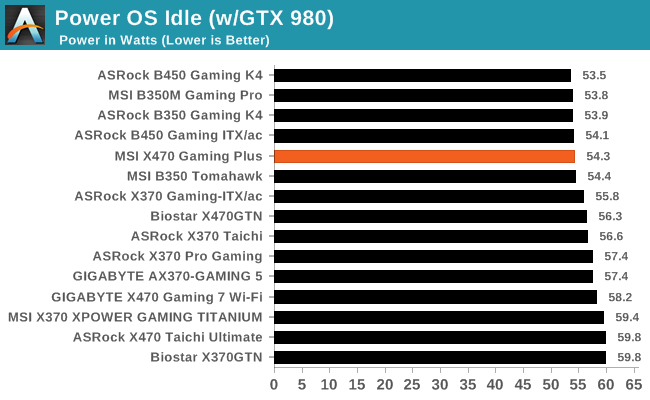
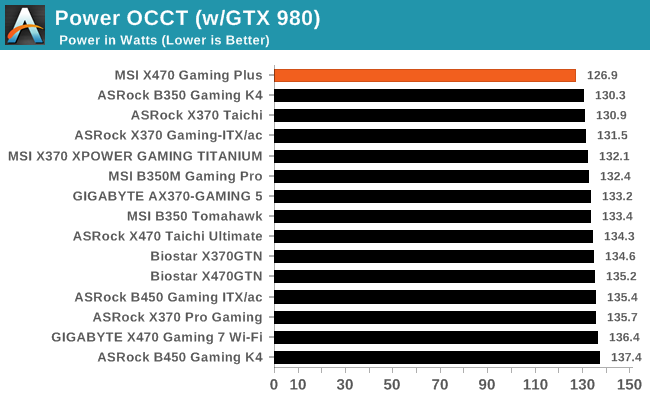
The power consumption in both in a long idle and idle states are pretty good considering for an ATX option and it's clear that the power reduced nature of the second generation of AM4 boards chipsets (B450/X470) seems to have done the trick, at least for MSI on the X470 Gaming Plus. Power at load under OCCT managed to achieve one of the lowest power draws from an AM4 motherboard to date.
Non-UEFI POST Time
Different motherboards have different POST sequences before an operating system is initialized. A lot of this is dependent on the board itself, and POST boot time is determined by the controllers on board (and the sequence of how those extras are organized). As part of our testing, we look at the POST Boot Time using a stopwatch. This is the time from pressing the ON button on the computer to when Windows starts loading. (We discount Windows loading as it is highly variable given Windows specific features.)

While normally average in terms, MSI's AM4 boards usually achieve some level of consistency within the boards previously tested, so it seems strange that the MSI X470 Gaming Plus completely falls behind the rest of the pack. Even with a re-install the times remained quite long with around 26 seconds under both default and stripped. While this could have been down to an anomaly, a fresh Windows 10 install was installed, the SATA port was changed but still the time taken to boot failed to improve.
Rightmark Audio Analyzer 6.2.5
Rightmark:AA indicates how well the sound system is built and isolated from electrical interference (either internally or externally). For this test we connect the Line Out to the Line In using a short six inch 3.5mm to 3.5mm high-quality jack, turn the OS speaker volume to 100%, and run the Rightmark default test suite at 192 kHz, 24-bit. The OS is tuned to 192 kHz/24-bit input and output, and the Line-In volume is adjusted until we have the best RMAA value in the mini-pretest. We look specifically at the Dynamic Range of the audio codec used on the rear panel of the board.
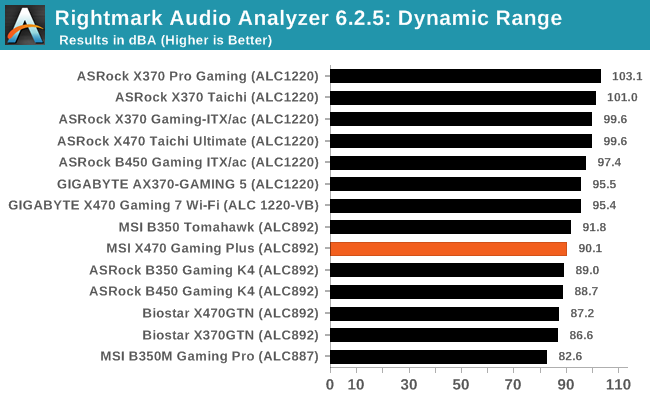
Our Rightmark Audio Analyzer dynamic range testing remains consistent with the Realtek ALC892 clad X470 Gaming Plus sits directly below MSI's own B350 Tomahawk in terms of audio performance.
DPC Latency
Deferred Procedure Call latency is a way in which Windows handles interrupt servicing. In order to wait for a processor to acknowledge the request, the system will queue all interrupt requests by priority. Critical interrupts will be handled as soon as possible, whereas lesser priority requests such as audio will be further down the line. If the audio device requires data, it will have to wait until the request is processed before the buffer is filled.
If the device drivers of higher priority components in a system are poorly implemented, this can cause delays in request scheduling and process time. This can lead to an empty audio buffer and characteristic audible pauses, pops and clicks. The DPC latency checker measures how much time is taken processing DPCs from driver invocation. The lower the value will result in better audio transfer at smaller buffer sizes. Results are measured in microseconds.
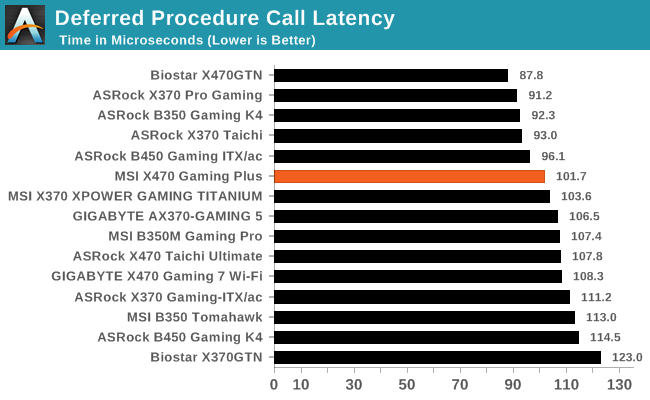
None of the manufacturers AM4 offerings so far have been optimized for DPC latency but despite this, the MSI X470 Gaming Plus puts in a good showing compared to most of the other options previously tested.
CPU Performance, Short Form
For our motherboard reviews, we use our short form testing method. These tests usually focus on if a motherboard is using MultiCore Turbo (the feature used to have maximum turbo on at all times, giving a frequency advantage), or if there are slight gains to be had from tweaking the firmware. We put the memory settings at the CPU manufacturers suggested frequency, making it very easy to see which motherboards have MCT enabled by default.
Video Conversion – Handbrake v1.0.2: link
Handbrake is a media conversion tool that was initially designed to help DVD ISOs and Video CDs into more common video formats. For HandBrake, we take two videos and convert them to x264 format in an MP4 container: a 2h20 640x266 DVD rip and a 10min double UHD 3840x4320 animation short. We also take the third video and transcode it to HEVC. Results are given in terms of the frames per second processed, and HandBrake uses as many threads as possible.
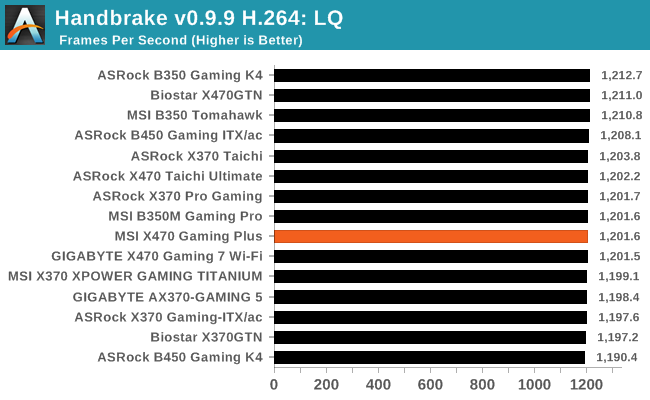
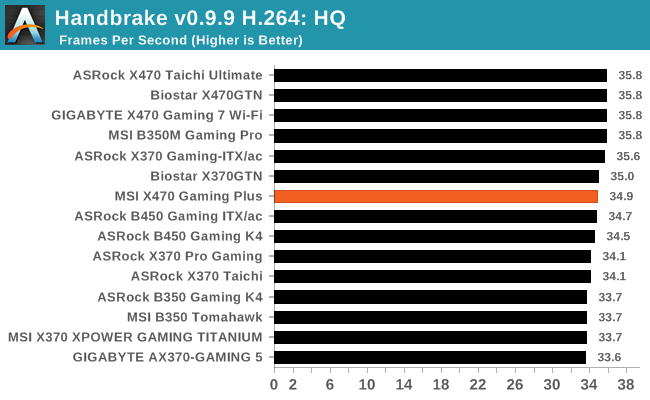

Compression – WinRAR 5.4: link
Our WinRAR test from 2013 is updated to the latest version of WinRAR at the start of 2017. We compress a set of 2867 files across 320 folders totaling 1.52 GB in size – 95% of these files are small typical website files, and the rest (90% of the size) are small 30 second 720p videos.
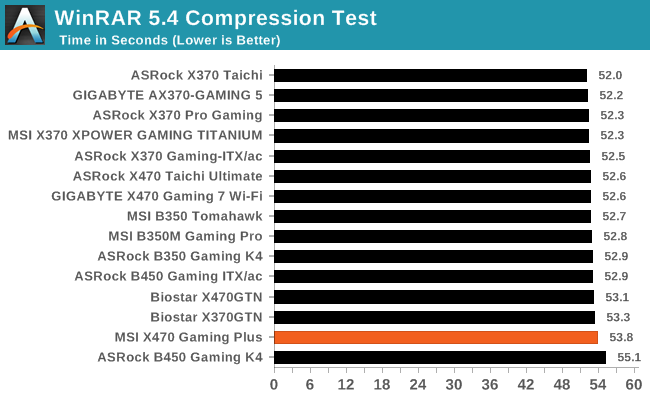
Point Calculations – 3D Movement Algorithm Test v2.1: link
3DPM is a self-penned benchmark, taking basic 3D movement algorithms used in Brownian Motion simulations and testing them for speed. High floating point performance, MHz and IPC wins in the single thread version, whereas the multithread version has to handle the threads and loves more cores. For a brief explanation of the platform agnostic coding behind this benchmark, see my forum post here. We are using the latest version of 3DPM, which has a significant number of tweaks over the original version to avoid issues with cache management and speeding up some of the algorithms.
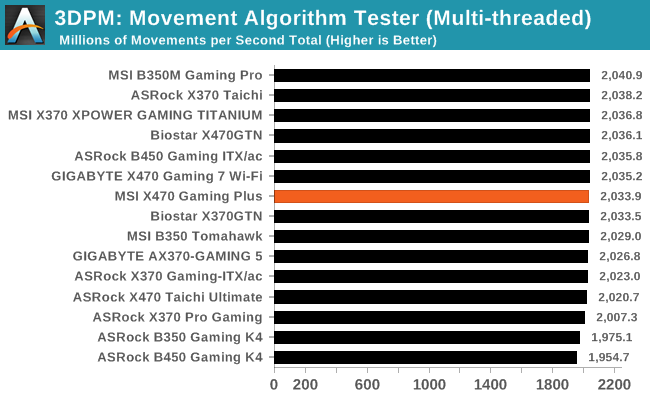
Rendering – POV-Ray 3.7.1b4: link
The Persistence of Vision Ray Tracer, or POV-Ray, is a freeware package for as the name suggests, ray tracing. It is a pure renderer, rather than modeling software, but the latest beta version contains a handy benchmark for stressing all processing threads on a platform. We have been using this test in motherboard reviews to test memory stability at various CPU speeds to good effect – if it passes the test, the IMC in the CPU is stable for a given CPU speed. As a CPU test, it runs for approximately 2-3 minutes on high end platforms.

Synthetic – 7-Zip 9.2: link
As an open source compression tool, 7-Zip is a popular tool for making sets of files easier to handle and transfer. The software offers up its own benchmark, to which we report the result.

Gaming Performance
Ashes of the Singularity
Seen as the holy child of DirectX12, Ashes of the Singularity (AoTS, or just Ashes) has been the first title to actively go explore as many of DirectX12s features as it possibly can. Stardock, the developer behind the Nitrous engine which powers the game, has ensured that the real-time strategy title takes advantage of multiple cores and multiple graphics cards, in as many configurations as possible.

Rise Of The Tomb Raider
Rise of the Tomb Raider is a third-person action-adventure game that features similar gameplay found in 2013's Tomb Raider. Players control Lara Croft through various environments, battling enemies, and completing puzzle platforming sections, while using improvised weapons and gadgets in order to progress through the story.
One of the unique aspects of this benchmark is that it’s actually the average of 3 sub-benchmarks that fly through different environments, which keeps the benchmark from being too weighted towards a GPU’s performance characteristics under any one scene.
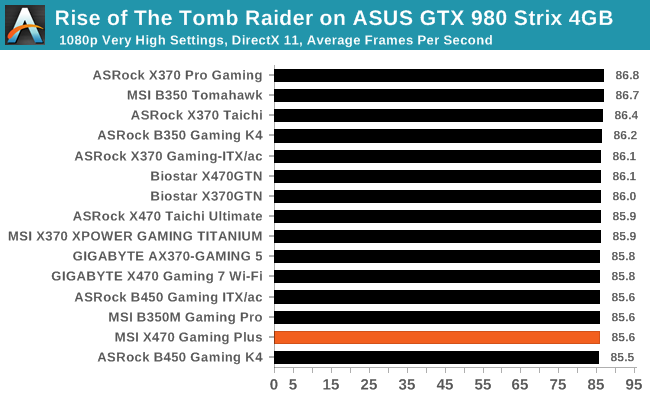
Thief
Thief has been a long-standing title in PC gamers hearts since the introduction of the very first iteration which was released back in 1998 (Thief: The Dark Project). Thief as it is simply known rebooted the long-standing series and renowned publisher Square Enix took over the task from where Eidos Interactive left off back in 2004. The game itself utilises the fluid Unreal Engine 3 engine and is known for optimised and improved destructible environments, large crowd simulation and soft body dynamics.
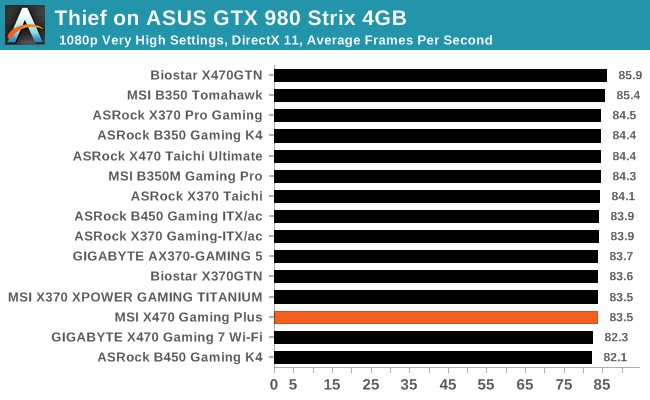
Total War: WARHAMMER
Not only is the Total War franchise one of the most popular real-time tactical strategy titles of all time, but Sega delve into multiple worlds such as the Roman Empire, Napoleonic era and even Attila the Hun, but more recently they nosedived into the world of Games Workshop via the WARHAMMER series. Developers Creative Assembly have used their latest RTS battle title with the much talked about DirectX 12 API so that this title can benefit from all the associated features that comes with it. The game itself is very CPU intensive and is capable of pushing any top end system to their limits.
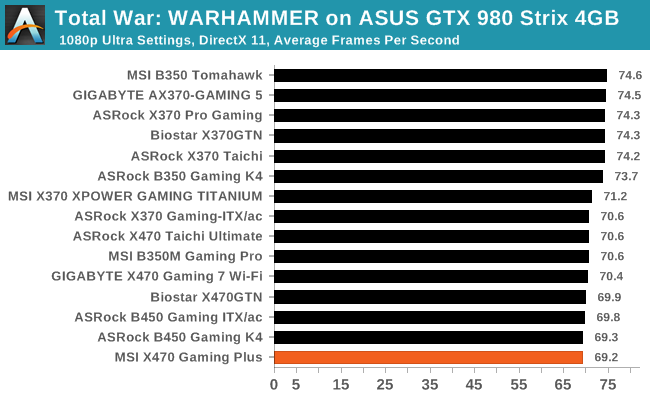
Ryzen Overclocking
Experience With the MSI X470 Gaming Plus
One of the most desirable aspects of the B and X marked AM4 socketed motherboards (B350, B450, X370 & X470) is that they have overclocking support with the entire range of Ryzen first and second-generation desktop processors as well as the Ryzen 2000 series APUs. Even though the MSI X470 Gaming Plus is targeted as an entry-level option for gamers to sink their teeth into, MSI’s decision to add an additional 4-pin 12 V ATX power input in addition to the 8-pin ATX connector most ATX sized boards feature means MSI has done one of two things. Firstly, it can signify that MSI is taking overclocking more seriously going forward that their entry-level model has more to offer for enthusiasts on a budget, or secondly that they thought it would increase the marketability to users who get dazzled into thinking more of something means better. Despite the fanfare given to something which isn’t even that important in the grand scheme of things, the MSI UEFI Click BIOS 5 interface is easy to use and users looking to avoid manually overclocking their CPU and memory can do so with the Game Boost button and the A-XMP buttons respectively. For a Ryzen 7 1700 processor such as the one we are using for the AM4 test bed, the settings applied using Game Boost are modest at best with an extra 200 MHz applied at a CPU VCore of 1.2 V. This equates to a maximum clock speed of 3.2 GHz under maximum load.
Users looking to make manual adjustments can find all the relative and useful settings regarding overclocking in the OC section with options such as CPU ratio which allows users to adjust the CPU core frequency up in 100 MHz increments. Voltage control is also adjustable and present with CPU core voltage and DRAM voltage being the most notable, but users using the Ryzen 2000 series APUs should note that the X470 Gaming Plus does include SoC voltage control through the CPU NB/SoC voltage setting.
Our Ryzen 7 1700 1000-series processor has a limit of around 4.0 GHz with a voltage range of 1.36-1.40 volts which is ultimately down to the quality of the silicon within. While there are Ryzen 7 1700 chips out there that have managed up to and including 4.3 GHz with ambient cooling, every piece of silicon reacts differently and is a consequence of what overclockers like to call ‘playing the silicon lottery’.
Methodology
Our standard overclocking methodology is as follows. We select the automatic overclock options and test for stability with POV-Ray and OCCT to simulate high-end workloads. These stability tests aim to catch any immediate causes for memory or CPU errors.
For manual overclocks, based on the information gathered from previous testing, starts off at a nominal voltage and CPU multiplier, and the multiplier is increased until the stability tests are failed. The CPU voltage is increased gradually until the stability tests are passed, and the process repeated until the motherboard reduces the multiplier automatically (due to safety protocol) or the CPU temperature reaches a stupidly high level (100ºC+). Our test bed is not in a case, which should push overclocks higher with fresher (cooler) air.
Overclocking Results
The X470 Gaming Plus did output a little more voltage than was requested within the BIOS for each 100 MHz strap on the CPU frequency with an incremental increase as the core frequency went higher culminating in a 0.03 V increase from 1.45 to 1.48 V at the 4.1 GHz; which was consequentially unstable anyway. The overclocking performance of the X470 Gaming Plus was positive with no serious voltage irregularity throughout the testing and POV-Ray performance was consistent aside from at 3.4 GHz where it fell short of what was expected; this is put down to an anomaly. At the maximum stable limit of our Ryzen 7 1700 processor the board put 1.408 V through the chip at maximum load with a set voltage in the BIOS of 1.375 V. It should also be noted that the single Game Boost setting provided seemed to provide the same level of performance as if the processor was set at 3.9 GHz manually which means that the 200 MHz increase over the default base core frequency of 3.0 GHz is boosting under load at 3.9 GHz at 1.208 V which is very respectable as far as automatic overclocking profiles go.
MSI X470 Gaming Plus Conclusion
The MSI X470 Gaming Plus is designed for gamers and users looking for an entry-level and good value X470 motherboard as the foundation for a Ryzen powered system. This particular ATX motherboard has a black and red synonymous with MSI’s gaming dragon clad theme, but with customizable RGB backlighting. While some users may not agree with the design implementation of boards with RGB backlighting integrated and set bright accented components on the board, but design preference is a matter of perspective and I quite like it.
The crux of any motherboard review boils down to performance and the X470 Gaming Plus is a good performer for the price point it currently sits at. The overall performance was competitive within our benchmarking suite with the biggest positives coming in power consumption with this board showing some of the lowest and most efficient results from an AM4 motherboard so far. This is no doubt down to the reduction in power from the first generation of AM4 chipsets (B350/X370) with the newer B450 and X470 chipsets having an idle wattage of around 2 W. Compute and gaming performance triggered no concerns with the poorest result coming when booting into Windows. Just like we experienced on our test bench with the MSI MEG X399 Creation TR4 motherboard, the non-UEFI POST time was absurdly higher than the other boards on test. Audio performance was as expected as can be when equipped with a Realtek ALC892 HD audio codec and the overclocking experience was painless as our Ryzen 7 1700 managed to hit its apex of 4.0 GHz very easily indeed.
With MSI actively advertising the board as an 11-phase power delivery, it comes as a bit of an issue. What’s actually underneath the red and black colored heatsinks paints a different picture with a Richtek RT8894A PWM controller only capable of running a 4+2 configuration. MSI hasn't used any phase doublers, but is using a pair of fets/chokes per phase, which isn't proper 'doubling'. It gives the illusion it’s beefier than it actually is.
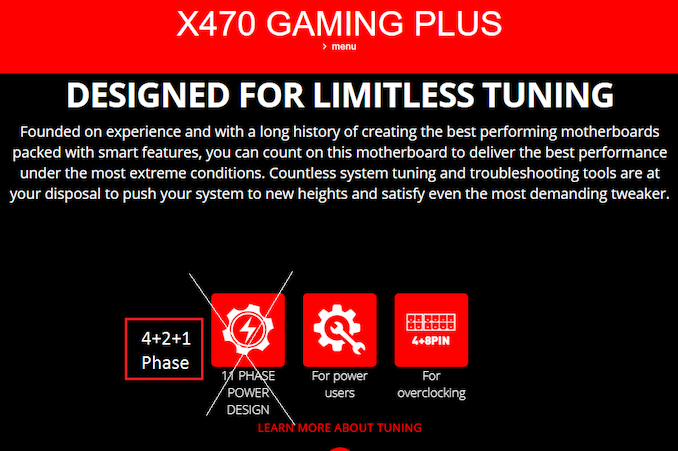
From the MSI Website, and we've crossed it out
That being said, this isn’t a new practice, but if MSI is to be one of the vendors to continue doing more and more like this, it sets a worrying precedent. Since we started cataloguing this issue, here are our results.
| AM4 Motherboard Power Delivery Comparison | ||||||
| AnandTech | Controller | Doubler | True CPU Phases | H Side |
L Side |
Chokes |
| ASRock | ||||||
| B450 Gaming ITX/ac | ISL95712 (6+2) | - | 6 | 10 | 10 | 8 |
| B450 Gaming K4 | ISL95712 (3+3) | - | 3 | 12 | 9 | 9 |
| X470 Taichi Ultimate | IR35201 (6+2) | 8 | 6x2 = 12 | 16 | 16 | 16 |
| Biostar | ||||||
| Biostar X370GTN | ISL95712 (4+3) | - | 4 | 7 | 7 | 7 |
| Biostar X470GTN | ISL95712 (4+3) | - | 4 | 7 | 7 | 7 |
| GIGABYTE | ||||||
| X470 Gaming 7 Wi-Fi | IR35201 (6+2) | 5 | 5x2 = 10 | 12 | 12 | 12 |
| MSI | ||||||
| X370 Gaming Titanium | IR35201 (6+2) | 5 | 5x2 = 10 | 10 | 16 | 10 |
| X470 Gaming Plus | RT8894A (4+2) | - | 4 | 14 | 14 | 11 |
With overclocking, the heatsinks are actually good and although a little warm (like most) under maximum load, there was no concerns running this board at 4.0 GHz with 1.4 V under maximum load.
What MSI feel is worth $120 packs quite a punch with eight USB ports including two USB 3.1 Gen2 Type-A ports giving users access to the limited devices which can make use of the 10 Gbps throughput, with a total of four internal headers giving expandability up to a maximum of eight additional USB ports (four USB 3.0 and four USB 2.0). The inclusion of a DVI-D and HDMI 2.0 port will be a big hit with users looking to build an ATX sized value gaming system with one of the Ryzen 2000 series APUs such as a Ryzen 5 2400G and Ryzen 3 2200G. The single LAN port takes its orders from a Realtek RTL8118H networking controller which gives users wired gigabit connectivity.
The top full-length PCIe 3.0 x16 slot has a coating of MSI’s Steel Slot armor protection while the other PCIe slots which consists of a second full-length PCIe 3.0 x8, a full-length PCIe 2.0 x4 and three PCIe 2.0 x1 slots do not. The X470 Gaming Plus offers up to three-way CrossFire multi-graphics support but SLI isn’t supported which incidentally is one of the biggest reasons to choose the X470 chipset over the more value for money B450 chipset - MSI saves money by not going after the SLI license. A key difference which sets this board apart from a B450 chipset board is the inclusion of six SATA ports which IS a benefit of X470. Finishing off the storage is a pair of M.2 slots which unfortunately comes without heatsinks with the top M.2 slot having support for PCIe 3.0 x4 for NVMe capable drives, whereas the second slot only has support for PCIe 2.0 x4 drives; both slots are compatible with SATA drives and the second slot shares bandwidth with either the bottom full-length PCIe 2.0 x4 slot, or SATA port number one, dependent on what type of drive is installed.
Despite the issue with MSI's marketing, for $120 it’s hard to go wrong and what MSI has equipped the X470 Gaming Plus with is more than acceptable. Some may grumble that there is no USB Type-C port featured and others may think that the exclusion of SLI support is too much to cope with, but this is an entry-level motherboard with a competent, yet overstated power delivery and has plenty of good points going for it including the MSI Click BIOS 5 UEFI firmware and the usual MSI gaming-focused software package to compliment it. Besides users looking to run an SLI gaming system is most likely going to be looking at options such as the MSI X470 Gaming M7 AC ($210). The MSI X470 Gaming Plus is a formidable option in the low to mid-range motherboard market and as such should be popular with gamers, system builders and users looking to make use of the multi-core and multi-threaded power of the Ryzen desktop processors while keeping within the remit of a reasonable price budget.

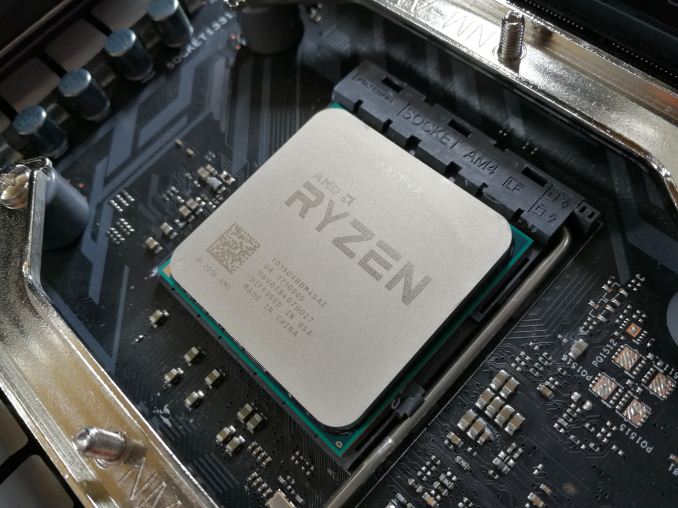
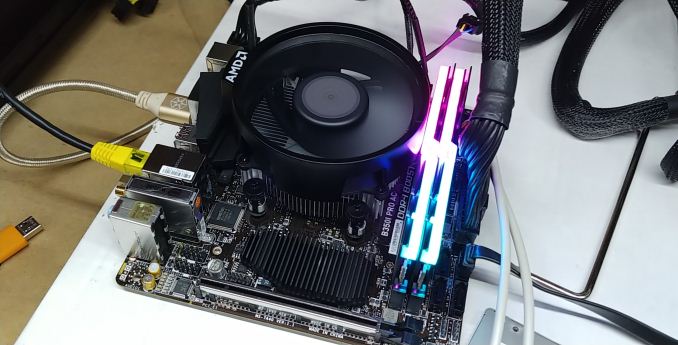
%20-%20Copya_678x452.jpg)
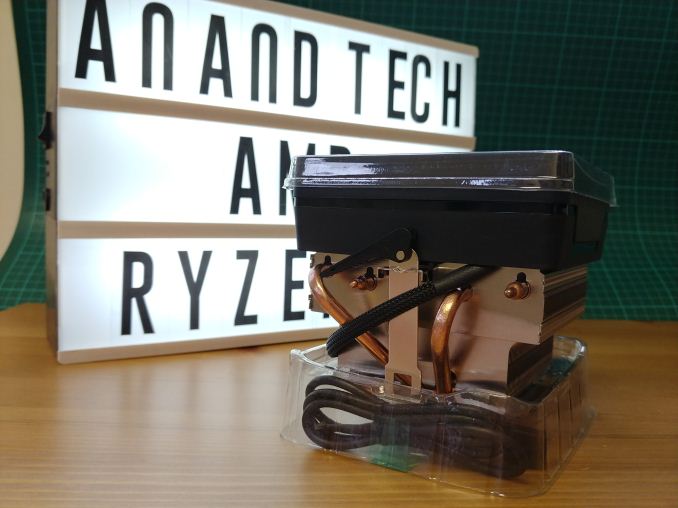
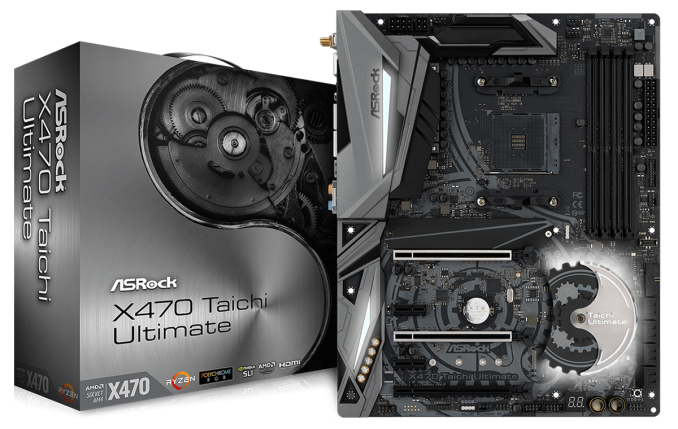

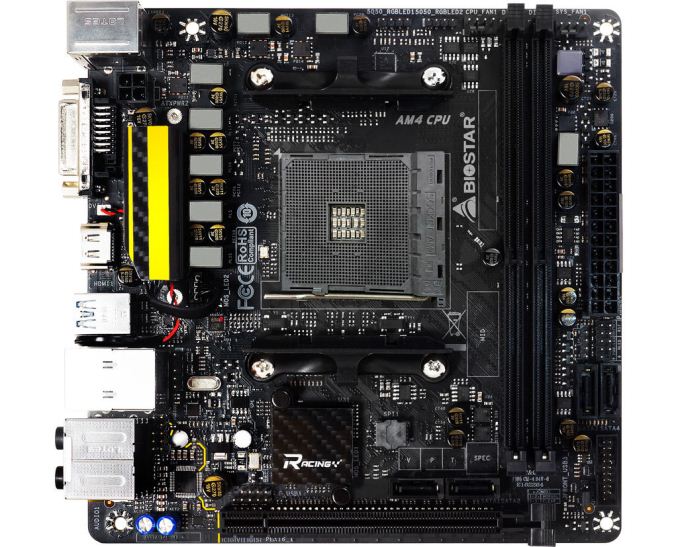
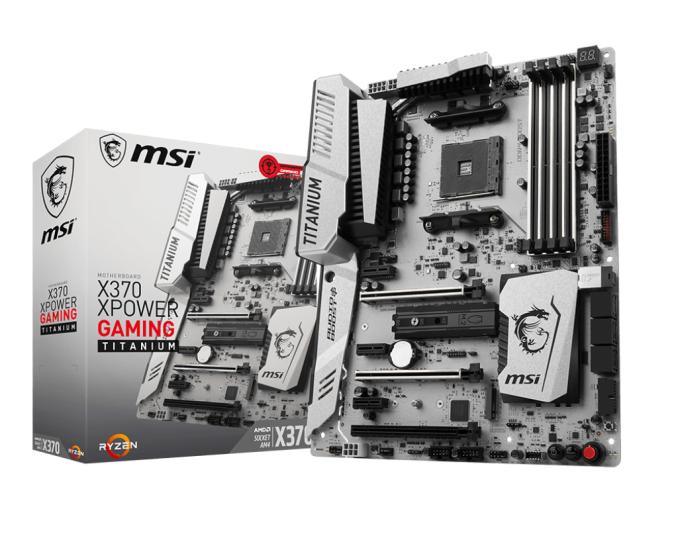

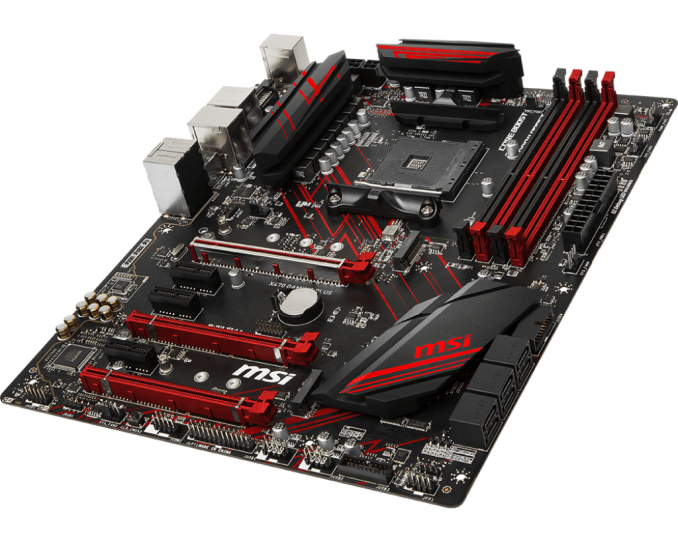
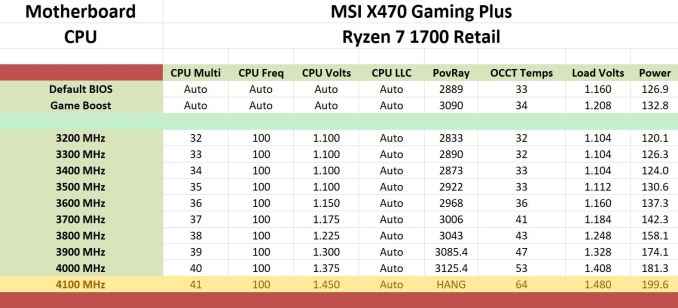
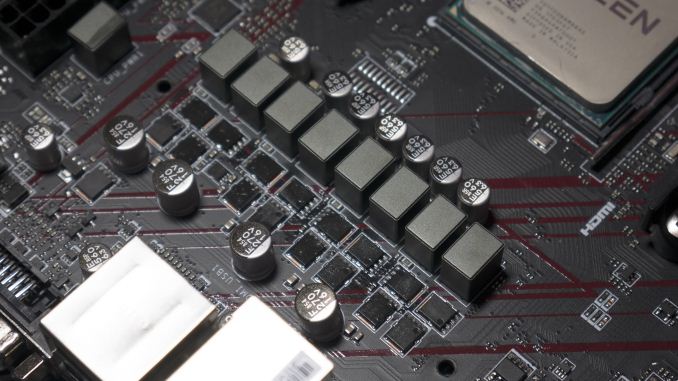
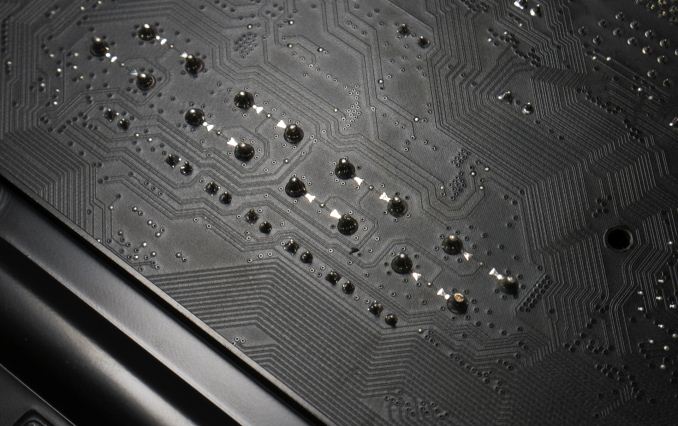
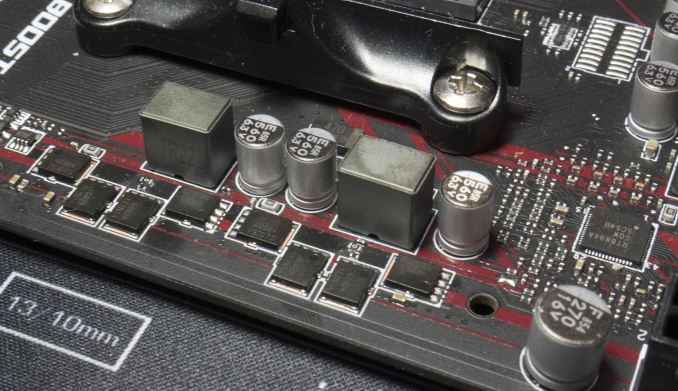


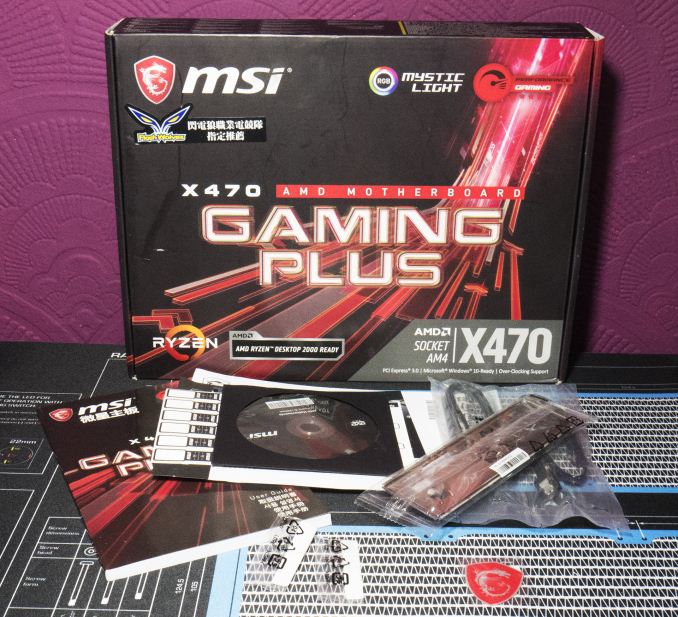
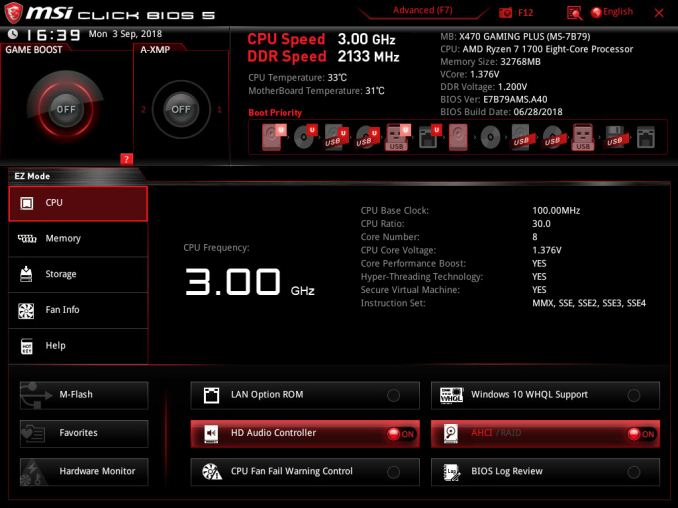



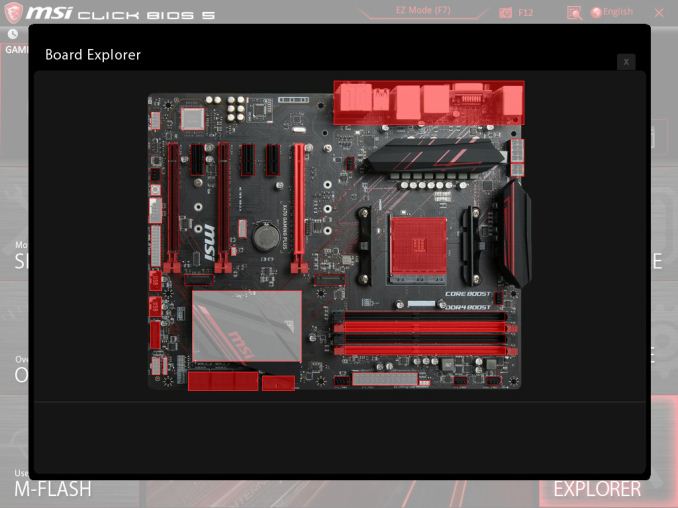
_thumb.jpg)
_thumb.jpg)
_thumb.jpg)
_thumb.jpg)
_thumb.jpg)
_thumb.jpg)
